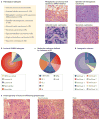Triple-negative breast cancer: challenges and opportunities of a heterogeneous disease
- PMID: 27184417
- PMCID: PMC5461122
- DOI: 10.1038/nrclinonc.2016.66
Triple-negative breast cancer: challenges and opportunities of a heterogeneous disease
Abstract
Chemotherapy is the primary established systemic treatment for patients with triple-negative breast cancer (TNBC) in both the early and advanced-stages of the disease. The lack of targeted therapies and the poor prognosis of patients with TNBC have fostered a major effort to discover actionable molecular targets to treat patients with these tumours. Massively parallel sequencing and other 'omics' technologies have revealed an unexpected level of heterogeneity of TNBCs and have led to the identification of potentially actionable molecular features in some TNBCs, such as germline BRCA1/2 mutations or 'BRCAness', the presence of the androgen receptor, and several rare genomic alterations. Whether these alterations are molecular 'drivers', however, has not been clearly established. A subgroup of TNBCs shows a high degree of tumour-infiltrating lymphocytes that also correlates with a lower risk of disease relapse and a higher likelihood of benefit from chemotherapy. Proof-of-principle studies with immune-checkpoint inhibitors in advanced-stage TNBC have yielded promising results, indicating the potential benefit of immunotherapy for patients with TNBC. In this Review, we discuss the most relevant molecular findings in TNBC from the past decade and the most promising therapeutic opportunities derived from these data.
Conflict of interest statement
G.B received honorarium from Roche. L.G. had an advisory role for Merck and Roche. J.M.B., I.A.M. and M.E.S. declare no competing interests.
Figures



References
Publication types
MeSH terms
Substances
Grants and funding
LinkOut - more resources
Full Text Sources
Other Literature Sources
Medical
Miscellaneous

